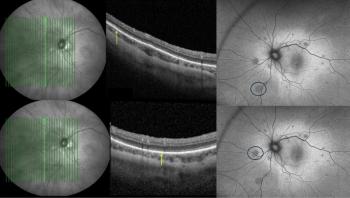
‘Real-world’ ocriplasmin macular hole closure rates lag trials
Ocriplasmin (Jetrea, ThromboGenics) may achieve lower macular hole closure rates than in trials, new British and Irish data suggests. Also, “the incidence of adverse events was greater than previously reported,” wrote RJ Haynes of Bristol Eye Hospital in Bristol, United Kingdom, and colleagues in the journal Eye.
Ocriplasmin (Jetrea, ThromboGenics) may achieve lower macular hole closure rates than in trials, new British and Irish data suggests.
Also, “the incidence of adverse events was greater than previously reported,” wrote RJ Haynes of Bristol Eye Hospital in Bristol, United Kingdom, and colleagues in the journal
Vitreomacular traction can reduce visual acuity and cause metamorphopsia and central field defect. Ocriplasmin is intended to treat this condition by cleaving fibronectin, laminin, and collagen in the vitreous body and vitreoretinal interface.
In two phase III controlled trials, ocriplasmin resolved vitreomacular adhesion and vitreomacular traction in 26.5% of cases within 28 days. By comparison, only 10.1% of cases treated with a placebo resolved in that amount of time (N. Engl. J. Med 2012;367,[7]:606-615).
Based on these Microplasmin for Intravitreous Injection-Traction Release without Surgical Treatment (MIVI TRUST) trials, the European Medicines Agency approved ocriplasmin in March 2012 for the treatment of vitreomacular traction, including cases associated with a macular hole of less than 400 µm.
The U.S. Food and Drug Administration (FDA) approved ocriplasmin for vitreomacular traction and symptomatic vitreomacular holes in October 2012, and the National Institute for Health and Care Excellence recommended it in October 2013 for use in England.
However, reports of adverse events have surfaced informally and in published case reports, prompting Haynes and colleagues to survey their colleagues in the British and Eire Association of VitreoRetinal Surgeons (BEAVRS).
They emailed all members of BEAVRS who had a registered email address in October 2014 and January 2015 and asked them report all cases of vitreomacular traction with or without full-thickness macular holes.
The researchers wanted to know how safe and effective the treatment would be in the “real-world” of clinical practice. Forty-one members responded that they had used ocriplasmin, and 7 that they had not, for a total response rate of 40%.
It is not clear from the survey what proportion of BEAVRS members use ocriplasmin, but at the organization’s annual meeting in 2014, only 8% said they would use the drug in a patient with a small full-thickness macular hole.
The members responding to the email survey reported injections in a total of 241 eyes. Their rate of release of pure vitreomacular traction was 34.1%, compared to 37.4% for the MIVI TRUST, a difference that was not statistically significant.
The BEAVRS closure rate was 42.1% for small full-thickness holes. By comparison, the MIVI TRUST trial achieved closure rates of 58.3%, a difference that was not significant by traditional metrics (P = 0.09).
The BEAVRS closure rate for medium sized holes was 12.7%, compared to the MIVI TRUST rate of 36.7% (P = 0.01), a difference which was considered statistically significant.
In addition, many of the BEAVRS physicians reported serious adverse events. In 5.8% of cases, vision dropped below 6/60, including one case of only perception of light that lasted for 24 hours.
Severe photopsia occurred in 11.6% of BEAVRS patients. Some patients described a “snow storm,” or “poorly tuned TV,” and others spoke of a “New Year’s Eve firework display.”
The BEAVRS physicians also reported dyschromatopsia, mainly a yellowing of dimming of vision, in 6.2% of patients.
Among the other adverse events in the BEAVRS patients:
· Changes in the outer segment ellipsoid layer on optical coherence tomography (OCT): 10.4%
· Among the 72% of failed cases, widening of the macular hole basal diameter on OCT: 46.9%
· One case of sub-retinal fluid/lucency in a region distal to the macular hole around the optic nerve including on the nasal side of the nerve.
· A rhegmatogenous retinal detachment occurred in all cases where a post ocriplasmin retinal tear occurred.
Surgeons performed electroretinography in some cases of severe vision loss and in six cases reported marked reduction in a- and b-wave amplitudes and a loss of oscillatory potentials suggesting widespread retinal dysfunction. These changes reverted to normal after a few months.
The BEAVRS physicians also reported zonular dialysis in four cases. Two of these occurred at the time of combined phacoemulsification, lens implant and pars plana vitrectomy surgery for macular holes that had not responded to ocriplasmin treatment.
“Grouped together, these observations indicate ocriplasmin has a more widespread action than the target vitreoretinal interface, and are suggestive of enzyme action both within the retina and the sub-retinal space, rather than just at the target vitreoretinal interface,” Haynes and colleagues wrote.
The rates of several categories of adverse event reported by the BEAVRS physicians were higher than in the MIVI TRUST, though the researchers did not report statistical significance. For example, the BEAVRS rate of retinal detachment was 3.3% compared to 0.4% in the MIVI TRUST. One contributing factor could be the exclusion of patients with high myopia from the MIVI TRUST trials, the researchers speculated.
Another possible explanation for the difference in results between the studies could be negative reporting bias; perhaps BEAVRS physicians were more likely to report results if they were disappointed, Haynes and colleagues suggested.
As alternative explanations, they also suggested there could be differences in technique among the physicians in the two studies, or differences in the populations.
Newsletter
Get the essential updates shaping the future of pharma manufacturing and compliance—subscribe today to Pharmaceutical Technology and never miss a breakthrough.













































